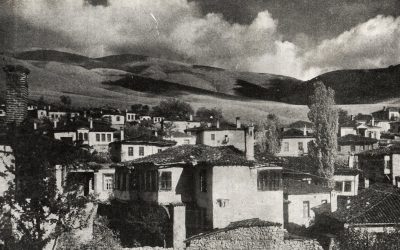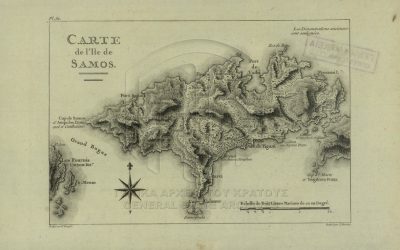By Gregory Kontos
Your grandfather was born in a village close to Chania, Crete in 1902. His name was Antonis, and you are wondering how common a name that was back then. His surname was Marinakis, and again you’re wondering “how many Marinakis were there in that area? If there were too many, it might be hard to identify my family. If there were too few, then they were likely a small family. Perhaps they had moved to the area from elsewhere. Or perhaps they were known by a different name in the past, and they had changed it at some point in time.” Until now, such questions were very difficult to answer. In fact, any “answers” were mere hypotheses, based on research experience: “I’ve seen this name in records” or “I’ve never come across this surname in the area again.” Yet, this empirical knowledge could never really be confirmed by any data, and the knowledge itself was individualized and thereby inaccessible to the public at large. In other words, the questions remained largely unanswered and confusions were inevitably commonplace.
Nevertheless, a new era has arrived in the field of Greek genealogy thanks to extensive digitization, quicker and cheaper remote research, and efforts made for the establishment of a concrete educational resource. Consequently, new research tools of tremendous added value have emerged for amateur and professional researchers alike. Greek Ancestry leads these new initiatives and launches a new series of articles providing the family history researcher with precious statistical insights.
| Ranking | Given Name | Relative Frequency (%) |
| 1. | Georgios (Γεώργιος) | 13.7% |
| 2. | Ioannis (Ιωάννης) | 11.7% |
| 3. | Emmanouil/Manolis (Εμμανουήλ/ Μανώλης) | 9.3% |
| 4. | Nikolaos (Νικόλαος) | 8.4% |
| 5. | Konstantinos (Κωνσταντίνος) | 5.8% |
| 6. | Michail (Μιχαήλ) | 5.2% |
| 7. | Antonios (Αντώνιος) | 4.9% |
| 8. | Dimitrios (Δημήτριος) | 4.7% |
| 9. | Stylianos (Στυλιανός) | 3.3% |
| 10. | Vasileios (Βασίλειος) | 2% |
| 11. | Panagiotis (Παναγιώτης) | 2% [1.96%] |
| 12. | Andreas (Ανδρέας) | 1.9% [1.93%] |
| 13. | Charalampos (Χαράλαμπος) | 1.1% |
| 14. | Theodoros (Θεόδωρος) | 1.1% |
| 15. | Iosif/Sifis (Ιωσήφ/Σήφης) | 1.1% |
| 16. | Kyriakos (Κυριάκος) | 1% |
| 17. | Stavros (Σταύρος) | 1% |
| 18. | Christos (Χρήστος) | 1% [0.97%] |
| 19. | Manousos (Μανούσος) | 0.9% [0.89%] |
| 20. | Spyridon (Σπυρίδων) | 0.9% [0.88%] |
Today’s article will focus on the prefecture of Chania, Crete and will present the top-20 male given names and surnames of Chania based on Greek Ancestry’s database of the area’s Male Registers. The dataset consists of approximately 113,000 given names and 56,500 surnames. It encompasses all the villages of the prefecture, and it predominantly covers the time period between 1850 and 1910 with less than 5% of the data representing years outside this range.
So, we arrive at the big question. What were the most common male given names of the prefecture of Chania during the period under study? Our findings were indeed very interesting.
To be sure, it comes as no surprise that the names “Georgios” (George) and “Ioannis” (John) feature as the first two most frequent given names in our data, accounting for 13.7% and 11.7%, respectively, of all the given names. Certainly, these names have been very popular throughout Greece. “Manolis” (Emmanouil – Emmanouel) comes in third place with a relative frequency of 9.3%, outnumbering “Nikolaos,” which comes in fourth place with 8.4%. Interestingly, these top-4 names together represent roughly 43% of the 113,000 given names in our dataset. The remainder of the given names lack behind significantly. “Konstantinos” comes in fifth with a relative frequency of 5.8% and is very close with “Michail” (5.2%). “Antonios” and “Dimitrios” account for 4.9% and 4.7% of the given names, respectively, followed by “Stelios” (Stylianos) (3.3%) and “Vasileios” (2%). We now have identified the top-10 most common given names, and all together they account for 69% of the given names in Chania between 1850-1910.
Surprisingly, the very local and supposedly common Cretan names such as “Sifis” (Iosif) and “Manousos” only account for 1% and 0.8% of the given names in the data, appearing 1,203 and 1,010 times, respectively. In fact, some very popular names of the Greek mainland, such as “Panagiotis” and “Andreas” actually appear more frequently, accounting for 1.96% and 1.93% of the given names, accordingly. However, the name “Christos” only shows a frequency of less than 1%, coming in 18th on the list. In total, the top-20 male given names (see table below) account for 81% of the names in the dataset.
| Ranking | Surname | Relative Frequency (%) |
| 1. | Papadakis (Παπαδάκης) | 1.6% |
| 2. | Daskalakis (Δασκαλάκης) | 0.7% |
| 3. | Maragkoudakis (Μαραγκουδάκης) | 0.5% |
| 4. | Petrakis (Πετράκης) | 0.5% |
| 5. | Galanakis (Γαλανάκης) | 0.4% |
| 6. | Pantelakis (Παντελάκης) | 0.4% |
| 7. | Papoutsakis (Παπουτσάκης) | 0.4% |
| 8. | Paterakis (Πατεράκης) | 0.4% |
| 9. | Marinakis (Μαρινάκης) | 0.4% |
| 10. | Nikolakakis (Νικολακάκης) | 0.4% |
| 11. | Angelakis (Αγγελάκης) | 0.4% |
| 12. | Apostolakis (Αποστολάκης) | 0.4% |
| 13. | Chatzidakis (Χατζιδάκης) | 0.4% |
| 14. | Kastrinakis (Καστρινάκης) | 0.4% |
| 15. | Stamatakis (Σταματάκης) | 0.3% |
| 16. | Theodorakis (Θεοδωράκης) | 0.3% |
| 17. | Mylonakis (Μυλωνάκης) | 0.3% |
| 18. | Stavroulakis (Σταυρουλάκης) | 0.3% |
| 19. | Perakis (Περάκης) | 0.3% |
| 20. | Mathioudakis (Μαθιουδάκης) | 0.3% |
The data paints a strikingly different picture when we examine the most common surnames in Chania during this time period. The most common surname appears to be “Papadakis” with a relative frequency of 1.6%. The second most common surname, “Daskalakis,” falls significantly behind with a frequency of only 0.7%. “Maragkoudakis” and “Petrakis” hold places #3 and #4 on the list, with a shared frequency of 0.5%. Together, the top-4 most common surnames only account for 3.3% of all the surnames from the area. From rankings #5 to #14, the percentages do not greatly differ. Indeed, the last six surnames on the list only show a frequency of about 0.3% each.
Thus, the data reveals that the top-20 most common surnames of the prefecture of Chania only comprise 9.1% of the surnames found in the dataset. If this figure is compared to our previous finding, that the top-20 male given names from Chania account for 81% of all the names in the dataset, then the difference here is surely obvious. Indeed, what this difference underscores is the richness of Chania’s surnames. In other words, if diversity is the criterion, then Chania’s surnames certainly win. In total, around 9,100 distinct surnames appear in the dataset of 56,500 names. On the contrary, only around 800 unique given names are found in the dataset of 113,000.
As similar analyses for naming patterns in more areas of Greece will become available, we’ll be able to determine whether the same conclusions are generally applicable or whether they consitute Chaniot particularities, which of the given names appearing in Chania do not show up in other areas and vice versa.
Notes: (1) Greek Ancestry’s database of Male Registers of the prefecture of Chania, Crete, is based on the corresponding collections of the Historical Archives of Crete (Chania).
(2) Greek Ancestry’s database of Male Registers of the prefecture of Chania, Crete, is accessible through: https://greekancestry.net/chania/
(3) Cite this article: Gregory Kontos, ‘Statistics Meet Genealogy: Naming Patterns in Chania, Crete (1850s-1910)’, posted on GreekAncestry.net on June 24th, 2020.



